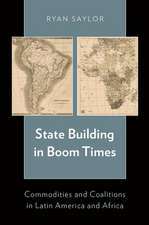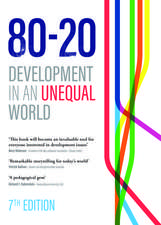Surveillance and Space: Society and Space
Autor Francisco Klauseren Limba Engleză Paperback – 18 dec 2016
- Who monitors whom, and how and why?
- How do surveillance techniques affect socio-spatial practices and relationships?
- How do they shape the fabrics of our cities, our mobilities, the spaces of the everyday?
- And what are the implications in terms of border control and the exercise of political power?
| Toate formatele și edițiile | Preț | Express |
|---|---|---|
| Paperback (1) | 384.00 lei 6-8 săpt. | |
| SAGE Publications – 18 dec 2016 | 384.00 lei 6-8 săpt. | |
| Hardback (1) | 875.05 lei 6-8 săpt. | |
| SAGE Publications – 18 dec 2016 | 875.05 lei 6-8 săpt. |
Preț: 384.00 lei
Nou
Puncte Express: 576
Preț estimativ în valută:
73.48€ • 76.57$ • 60.84£
73.48€ • 76.57$ • 60.84£
Carte tipărită la comandă
Livrare economică 03-17 aprilie
Preluare comenzi: 021 569.72.76
Specificații
ISBN-13: 9781473907775
ISBN-10: 1473907772
Pagini: 208
Dimensiuni: 156 x 234 x 15 mm
Greutate: 0.32 kg
Ediția:First Edition
Editura: SAGE Publications
Colecția Sage Publications Ltd
Seria Society and Space
Locul publicării:London, United Kingdom
ISBN-10: 1473907772
Pagini: 208
Dimensiuni: 156 x 234 x 15 mm
Greutate: 0.32 kg
Ediția:First Edition
Editura: SAGE Publications
Colecția Sage Publications Ltd
Seria Society and Space
Locul publicării:London, United Kingdom
Recenzii
Questions of surveillance are always also questions of geography. From the famous disciplinary spaces of Bentham's panoptic prison projects to today's control societies based on millions of sensors, cameras and data capture devices spread across the world, perspectives from critical geography offer massive potential for understanding surveillance societies. And yet, remarkably, this pivotal and state-of-the art book is the first to really consider the intersections of geography and surveillance with real depth and clarity. Theoretically cutting-edge, politically astute, technologically informed, athletically multiscaled -- 'Surveillance and Space' is a remarkable analysis and is a 'must read' for anyone interested in the fast-moving politics and geographies of surveillance in contemporary societies.
This book engages with the timely and significant debate around surveillance, space and power. These three elements have been recognized as crucial since the works of Foucault, but a lot has changed since, especially when it comes to IT-based techniques of control. This book discusses the contemporary political geography of surveillance and the surveillance–space nexus in many different contexts. Firmly grounded in previous understandings, Klauser examines the multifaceted ways in which space makes a difference to the exercise and experience of surveillance. His perspective expands from the Anglophone world to German and French research, and is thus unique. Especially the works of Sloterdijk and Raffestin deeply enrichen the current theories of surveillance and space. Klauser has an exceptional ability to bring scholars from different times, cultures and disciplines into ‘discussion’, resulting in constructive new understandings. These brave theoretical conceptualizations are supported by several illustrative empirical case studies, for example, on airports and mega-events. Klauser maps the new geographies of surveillance with great skill and deep understanding, resulting in a work that is essential reading for every surveillance studies researcher and student.
This book engages with the timely and significant debate around surveillance, space and power. These three elements have been recognized as crucial since the works of Foucault, but a lot has changed since, especially when it comes to IT-based techniques of control. This book discusses the contemporary political geography of surveillance and the surveillance–space nexus in many different contexts. Firmly grounded in previous understandings, Klauser examines the multifaceted ways in which space makes a difference to the exercise and experience of surveillance. His perspective expands from the Anglophone world to German and French research, and is thus unique. Especially the works of Sloterdijk and Raffestin deeply enrichen the current theories of surveillance and space. Klauser has an exceptional ability to bring scholars from different times, cultures and disciplines into ‘discussion’, resulting in constructive new understandings. These brave theoretical conceptualizations are supported by several illustrative empirical case studies, for example, on airports and mega-events. Klauser maps the new geographies of surveillance with great skill and deep understanding, resulting in a work that is essential reading for every surveillance studies researcher and student.
Cuprins
Introduction: Governing the Everyday in the Digital Age
Part I: Conceptual foundations
Chapter 1: Surveillance and the Everyday
Chapter 2: Surveillance and Mediation
Chapter 3: Surveillance and Power
Chapter 4: Surveillance and Space
Part II: Spatial Logics of Surveillance
Chapter 5: Punctual, Linear and Planar Logics of Surveillance
Chapter 6: Surveillance relating to Fixity and Flexibility, Enclosure and Openness
Chapter 7: Spherical Attributes of Surveillance
Part III: The Functioning of Surveillance in its Relation to Space
Chapter 8: Surveillance, Authority and Expertise
Chapter 9: Policy Mobilities and Exemplification in Surveillance Matters
Part IV: The Socio-spatial Implications of Surveillance
Chapter 10: Spatial Distancing and Separation
Chapter 11: The Orchestration and Automatic Production of Space
Conclusion: Towards a Political Geography of Surveillance
Part I: Conceptual foundations
Chapter 1: Surveillance and the Everyday
Chapter 2: Surveillance and Mediation
Chapter 3: Surveillance and Power
Chapter 4: Surveillance and Space
Part II: Spatial Logics of Surveillance
Chapter 5: Punctual, Linear and Planar Logics of Surveillance
Chapter 6: Surveillance relating to Fixity and Flexibility, Enclosure and Openness
Chapter 7: Spherical Attributes of Surveillance
Part III: The Functioning of Surveillance in its Relation to Space
Chapter 8: Surveillance, Authority and Expertise
Chapter 9: Policy Mobilities and Exemplification in Surveillance Matters
Part IV: The Socio-spatial Implications of Surveillance
Chapter 10: Spatial Distancing and Separation
Chapter 11: The Orchestration and Automatic Production of Space
Conclusion: Towards a Political Geography of Surveillance
Descriere
Considering the possibility of a “political geography of surveillance”, this book provides readers with a critical exploration of the interplay between surveillance and space



















